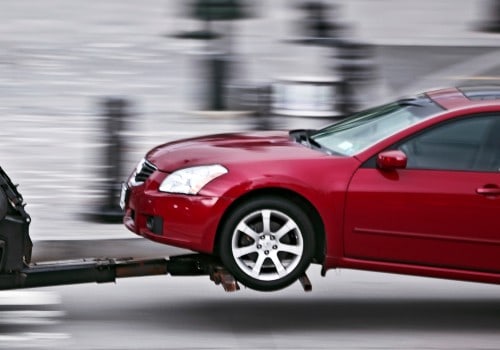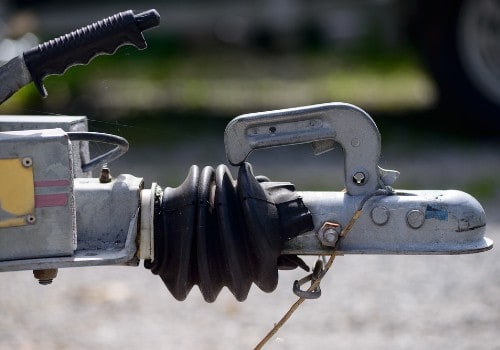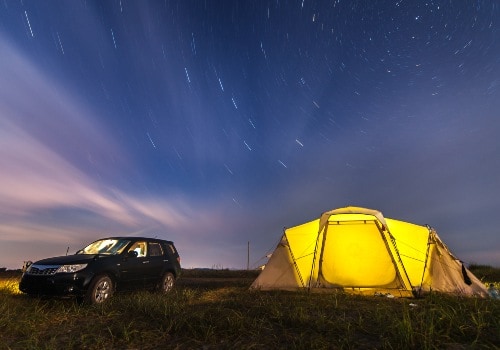Now that you’re enthralled in all things RV, you’re starting to notice all of the coaches on the roads during your daily commute. You’ve seen many motorhomes towing SUVs, but isn’t it strange that some of them are towing Cadillacs, sports cars, and even compact two-seaters? We’ll show you why as we explore what cars can be flat towed behind RVs.
The best way to tow a car behind an RV is to flat tow it. The best flat tow vehicles have manual transmission rear-wheel drive or 4×4 with a neutral setting.
For specific information on whether your vehicle has flat tow capabilities, refer to your car’s owner’s manual. Not all rear-wheel drive (RWD) or four-wheel drive (4×4) vehicles have this capability.
Talking Like A Camper

In the RV community, they may mention something about your Toad, Dinghy., or Four-Down Towing. Both of these words refer to the vehicle that you’re towing. If the RV dealer asks if you’re looking to toad with your new motorhome, they’re asking you if you’re looking to tow a passenger vehicle with your motorhome.
Rear Wheel Drive
Rear-wheel drive vehicles receive their power from the engine through a device called the driveshaft. This long tube stretches from the engine chamber to the rear axle (simplified for our purposes). When you set the transmission to neutral, the gears that supply power from the crankshaft separate from the gears that receive power for the driveshaft.
The separation allows the four wheels to spin freely. The driveshaft will still turn since the rear wheels are always connected. The transmission gears will rotate due to the driveshaft’s operation.
Your vehicle must also have a tow package pre-installed for it to operate in dinghy mode. Your car will have two connections to your RV. The first is the hitch itself. The second is the electronic umbilical cord that connects the RV’s electronics to the vehicle.
Your toad must have an electronic brake system (EBS), so it can stop itself (most states require vehicles to have it, and every automaker now makes EBS as a standard feature). The DOT lights must function in the car at the same time as the RV. When you activate your turn signal on your motorhome, your dinghy’s signal must blink as well.
If you have an older model passenger vehicle, there are aftermarket products you can purchase that fulfill the EBS requirement. Many of them are affordable and easy to install. Even if the authorities do not catch you, towing a vehicle that can’t stop itself is dangerous. If your motorhome has to stop its weight and the toad, the RV’s brakes could fail.
RWD 2020 Cars That Can Be Flat Towed Behind an RV
Generally, rear-wheel vehicles fall into four major categories; high-end luxury cars, sports cars, SUVs, and small cars. We’ll discuss many SUVs later, but 4×2 models made for city traffic are mostly RWD.
- 4×2 SUVs: Great examples of rear-wheel drive SUVs include the Toyota 4runner, BMW X3, and the Kia Sorento.
- High-End Luxury Cars:Top-end class A diesels or gasser deserve a well-matched Tuxedoed Toad like a Cadillac XTS, BMW 3 Series, or a Lexus IS.
- Sports Cars: If speed is what you need, hook up a Ford Mustang, Chevy Camero, or Dodge Challenger.
- Small Cars: Fuel-efficient dinghies are easy to tow and fit well on those New England historic roads. Some of the lightest cars to tow behind a motorhome include the Nissan Sentra, Fiat 500, or Kia Rio are great options to consider.
Overcoming the 200 Mile Rule
If you’re flat towing a rear-wheel-drive vehicle, you’ll need to stop every 200-miles. The driveshaft and transmission will need lubrication and cooling off, respectively.
Usually, when you drive your car, the driveshaft’s lubrication pump supplies fluid to prevent it from rubbing against its housing. The transmission cycles its fluid to grease and transfer heat away from the various components inside. While towing, those components are dormant.
Those that travel a lot on multi-day excursions may want to look into driveshaft decouplers and lubrication pumps. Your RV dealer can install these devices on your passenger vehicle (not your auto shop). The decoupler stops your driveshaft from spinning, and the pump keeps your transmission fluid cycling through the power it receives from the RV umbilical cord.
Your RV dealer will need to know the year, make, and model of your toad. They’ll tell you the final cost of the whole process. Once the parts come in, the work should take a matter of hours. Once you know the total price, you should weigh the pros and cons based on your RV travel habits.
Four Wheel Drive
4×4 vehicles have two different transmissions. The primary one has park, reverse, and drive on it. The second one is known as the transfer case. This one lets you choose between setting the vehicle between 4×2 or the various 4×4 options.
When you’re ready to flat tow, set the transfer case in neutral for towing. The auto manufacturers design this setting specifically for flat towing. The driveshaft and transmission aren’t active, so you don’t have to worry about the 200-mile rule.
4×4 and AWD 2020 Cars That Can Be Flat Towed Behind an RV
The Jeep Wrangler is the best 2020 car that can be flat towed behind an RV. That’s why you see it behind so many motorhomes so often. People like its fuel-efficient 4-cylinder or power V6.
Next year, we’ll see if the new Bronco overtakes the Wrangler as the best vehicle that can be flat towed. One of its major selling points is its toad-ready capabilities in all trim levels and the Sports version.
Meanwhile, you’ll find many large, full-size, and mid-size SUVs with 4×4 packages that are great to tow. All 4×4 foreign and domestic pickup trucks are excellent dinghies. The 4×4 packages include tow package pre-installation.
- Pickup Truck Examples: All Ford F-Series, Dodge Ram Series, GMC Sierras, Chevrolet Silverados, Nissan Titan (and HD), and Toyota Tundras.
- Large SUV Best Choices: Ford Expedition, Chevrolet Tahoe, Toyota Land Cruiser, Cadillac Escalade, Nissan Armada, and Infiniti QX
- Full-Size SUV Prime Options: Jeep Grand Cherokee, Chevrolet Traverse, Ford Explorer, Dodge Durango, and Land Rover Range Rover
- Mid-Size and Small SUV Top Picks: Nissan Pathfinder, Jeep Renagade, Mitsubishi Outlander, BMW X5, and Honda HR-V
For a complete list, check out Good Sam’s 2020 Dinghy Guide. Remember to check your owner’s manual to make sure your specific vehicle has the capability. Automakers have different trim levels with additional features. There could be some versions of your car that are tow ready; your particular vehicle may not come equipped with the key components.
Tow Bars

The best tow bars for flat towing your dinghy will have several features you want to have. They will have a V formation where two ends connect to the front chassis of your tow vehicle, and the opposite end connects to the RV’s ball hitch at a single point.
Some tow bars are solid aluminum or steel. Others will have shock absorbers within the bars. The goal when towing your toad is to keep it stable during the towing experience. These shocks help keep your car’s weight is balanced no matter the road conditions. It’s better for both your vehicle and your RV.
You can purchase an optional rock shield to protect your vehicle’s grill, hood, and windshield. Your motorhome may have mud flaps to prevent it from kicking up rocks and debris from flying up, but there’s nothing wrong with extra protection. Besides, do you want the windshield replacement folks joining you on your vacation?
One thing we can’t stress enough is connecting the safety chains or cables. Not only is it required by law, having them connected can mean the difference between a little or a lot of damage. Hitches are very reliable, but there have been incidences of them failing. If your hitch fails, the safety chains prevent your vehicle from flying free and creating a major disaster.
Trailer Alternatives
There is hope for those who love their front-wheel-drive car or aren’t ready to buy a new vehicle. Using a two-wheeled dolly, trailer, or box trailer to tow your vehicle is an alternative to flat towing. There are advantages to trailering your vehicle over flat towing.
One of the many advantages is the ability to rent dollies and flat trailers. If you mainly camp locally but are going on that once-in-a-lifetime trip, it may be a better option to rent one of these car trailers through U-haul or another service.
If you’re going to use a car trailer, you’ll want to check the campground rules ahead of time. Many of them have limitations on what’s allowed to stay at your campsite—usually, it’s your RV, your passenger vehicle, and a tent-like structure.
If the campground doesn’t let you store the car trailer at your campsite, they’ll have you move it to guest parking or storage area. Be prepared for an extra fee for the use of the space.
Two-Wheeled Dollies
Dollies are two-wheeled trailers that connect to the hitch of your motorhome. They are the least expensive, and many fold up to store under your RV when you’re not using them. They use either EBS brakes or surge brakes.
You’ll find that they are prone to sway when traveling. Ensure your vehicle has plenty of clearance between the road and the back bumper since it’ll be on an angle. If you use the dolly a lot, you’ll see uneven wear when you compare the rear and front tires.
Flat Trailer
Flat trailers come in either single or double axles. They’re more stable on the road and keep your tires from wearing unevenly. Due to their length, you won’t have to worry too much about sway.
These types of trailers protect your car from ground debris, but not from the sides or above. You might have height issues as well. You don’t want your vehicle to stick up higher than your RV. Underpasses and other clearance concerns can become a problem. They are best suited for sedans, coupes, and other car classes.
Box Trailers
Box trailers are the most expensive, but they have the most advantages. These mobile garages have a lot of utility space for additional storage. Make sure that whatever you store is very secure.
Fully enclosed trailers protect your vehicle from damage at any angle and guard from the weather. If you’re bringing your restored classic or rare beauty with you, this type of trailer is the best option. Many box trailer owners will have graphic artists custom paint the exterior to match their RV’s design to add some style.
What’s the Deal With Minivans?
Minivans are frustrating. Minivans with tow packages have towing strengths that allow you to pull teardrops, pop-ups, and small travel trailers. Towing a minivan behind an RV is a whole other matter. They’re primarily front-wheel drive and come with automatic transmissions.
The wheelbase on minivans are wider than cars, so they don’t fit on average car dollies, flat trailers, or box trailers. To safely tow your minivan, you’ll need a trailer designed for their wheelbase. Rental companies don’t commonly offer them. Your best bet is to buy a specialty car trailer.
The Best Used Cars to Tow Behind Motorhomes
There are some cars out there on used lots worth considering. Many are in great shape and have all of the mechanical requirements to make the perfect toad for your RV adventure.
Finding used vehicles already equipped with flat towing equipment can be found. There are more of them out there than you think. People trade them in for many different reasons. They trade them in due to downsizing to a towable, deciding to leave the RV lifestyle, and other lifestyle reasons.
Searching for a flat tow capable vehicle on your favorite car-buying websites like Autotrader or others will pull up hundreds of viable candidates for you. You may find some that already have flat tow hitch equipment already installed on the front chassis.
Special Model Years

During specific model years, automakers built their vehicles with the ability to be flat-towed. For example, the 2015 Chevrolet Malibu can be flat towed. If you try it with a 2016 or 2014, it won’t work. 2015 is the only model year in the automatic transmission that has toading capabilities.
Other specific model year vehicles include:
- 2016 Ford Fusion Hybrid
- 2006-2011 Chevrolet HHR
- 2002-2011 Jeep Liberty
- 2010-2014 Honda CR-V
- 2010-2012 Hyundai Sonata
- 2017 Lincoln Continental
- 2010-2011 Mazda Tribute
- 2016 Scion iM
- 2010-2014 All Subaru
- 2010-2013 Toyota Matrix
The Tale of the Smart Car ForTwo
Smart Car opened its doors in 1998. It debuted on our side of the “pond” in 2004, starting in Canada. The United States market didn’t see this subcompact until 2008. Its unique design and all-electric motor made a smash for the first few years here in the States, but Mercedes-Benz ultimately had to close it due to low sales.
Class A diesel motorhome owners loved the car because it was the lightest car to tow behind an RV. Instead of flat towing, these drivable coaches could support a heavy-duty cargo carrier that could hold the two-seater car.
Those that wanted to deck out their Smart Car could take advantage of the company’s removable exterior panel feature and have the car’s exterior match or compliment their RV.
Once they pulled into their campsite, the cargo carrier would fold up against the RV, so there wasn’t anything to store. The cargo carrier left enough space so it wouldn’t scratch the paint and didn’t get in the way of the diesel engine’s grill.
The last model year for the Smart Car Fortwo was 2019. There is still a fair amount of them waiting to be purchased. Since they are all-electric, all you need to do is plug them into your campsite’s shore power utility box.




